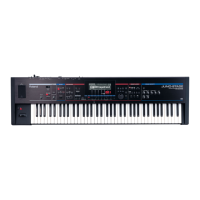118
Chapter 8. Detailed Editing for Patches
On an acoustic piano, pressing the damper pedal will allow the strings of notes other than the keys you played to resonate sympathetically, creating
a rich and spacious resonance. This parameter adjusts the degree of resonance.
1.
From the PIANO MODE (AC.PIANO) screen, use [ ] [ ] to move the cursor to “Resonance.”
2.
Use the VALUE dial or [DEC] [INC] to adjust the amount of resonance.
Here you can select effects that are frequently used with an electric piano. The parameters that can be edited will depend on the effect you’ve selected.
1.
In the PIANO MODE (EL.PIANO) screen, use the cursor buttons to
move the cursor to the effect name (below “EFFECT”).
2.
Use the VALUE dial or [DEC] [INC] to change the effect.
3.
Use the cursor buttons to select the parameter that you want to
edit.
4.
Use the VALUE dial or [DEC] [INC] to edit the value.
These effect settings are only for Piano mode. The effect you’ve specified in Piano mode will be applied regardless of the effect settings of the
patch you’ve selected.
Adjusting the Amount of Resonance (Resonance)
Parameter Value Explanation
Resonance
0–127 Increasing this value will increase the amount of resonance.
Selecting an Effect for the Electric Piano (EFFECT)
Effect name/
Parameter
Value Explanation
THRU: No effect will be applied.
Tremolo: Cyclically modulates the volume. The sound will appear to waver.
Wave
TRI, SQR, SIN, SAW1, SAW2
Type of modulation
Rate
0.05–10.00
Frequency of modulation
Depth
0–127
Depth of effect
Chorus: Adds a three-dimensional spaciousness and depth to the sound.
Rate
0.05–10.00
Frequency of modulation
Depth
0–127
Depth of modulation
Balance
D100:0W–D0:100W
Volume balance between the original sound (D) and
chorus sound (W)
Phaser: Adds a twisting character to the sound.
Manual
0–127
Center frequency at which the sound is modulated
Rate
0.05–10.00
Frequency of modulation
Depth
0–127
Depth of modulation
Resonance
0–127
Amount of feedback
EQ: Adjusts the tone of the high, mid, and low frequency ranges.
Low Gain
-15 [dB]–+15 [dB]
Amount of boost/cut for the low frequency range
Mid1 Gain
-15 [dB]–+15 [dB]
Amount of boost/cut for the mid-1 frequency range
Mid2 Gain
-15 [dB]–+15 [dB]
Amount of boost/cut for the mid-2 frequency range
High Gain
-15 [dB]–+15 [dB]
Amount of boost/cut for the high frequency range
Speaker: This simulates various speaker types as well as the settings for the microphone used to capture the sound from the speakers.
Speaker
SMALL 1, SMALL 2, MIDDLE, JC-120,
BUILT-IN 1, BUILT-IN 2, BUILT-IN 3, BUILT-IN 4, BUILT-IN 5,
BG STACK 1, BG STACK 2,
MS STACK 1, MS STACK 2, METAL STACK,
2-STACK, 3-STACK
Type of speaker
Mic Level
0–127
Volume of the mic
Direct Level
0–127
Volume of the direct sound
JUNO-STAGE_e.book 118 ページ 2008年10月17日 金曜日 午後12時27分

